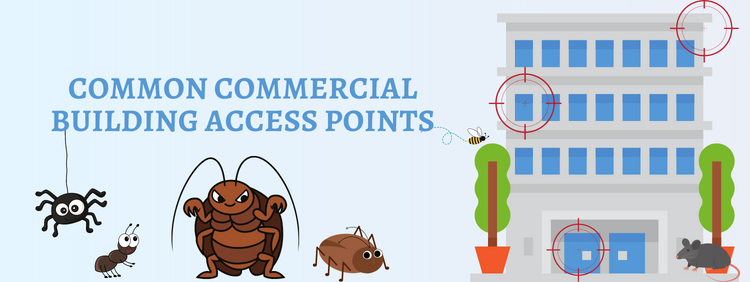
Pests can access commercial facilities in many ways, including consumer entrances. With the amount of traffic businesses see, keeping all bugs out of a building is challenging, regardless of prevention or treatment strategies. That said, controlling the amount and severity of insect intrusions is possible, especially with the help of commercial pest control in Kitchener.
Commercial facilities must use various strategies to prevent infestations. The techniques to prevent such problems usually depend on the type of institution, but they all involve sanitation and hygienic practices. Still, understanding how to implement prevention strategies comes from a place of knowledge, especially about pest behaviour.
Common Commercial Building Access Points
The size of commercial facilities makes them challenging to defend, or so it may seem. In truth, building owners protect their properties much the same way as residential property owners. The facility’s size plays a role in the difficulty of defence, but with routine maintenance and upkeep, there is no reason to believe a facility can’t be protected.
As with residential pest control, the initial stage of pest defence is understanding behaviour and preference. Insects, rodents, and other problem pests prefer to find vulnerable openings and access points throughout a facility. The vulnerabilities act as highways to a building’s interior. The three most common access points include walls and ceilings, pipes, and windows.
1. Walls and Ceilings
While some building owners might argue that interior walls and ceilings are the primary defence against infestations, they may not realize how interconnected the exterior and interior are with each other. If a building suffers damage on the outside, it can act as a passageway to the interior.
Many insect and rodent infestations stem from a crack in an exterior wall or a hole in the roofline. To prevent pest problems, it is crucial for building owners to keep up with annual and biannual inspections of their property, ensuring any damage gets repaired as it occurs.
2. Pipes
The plumbing in a building may not be as secure as some property owners believe. Often, pests will find gaps in seals around pipes entering a building. Also, if underground lines need repair, insects may take advantage of cracks, following the drain lines into the building.
While it is challenging to know what happens underground, property owners and maintenance staff can walk the property’s exterior to inspect areas where pipes and plumbing connections enter the facility. Seals around these access points should be solid.
3. Windows
Besides doorways, windows are the easiest way for pests to enter a commercial property. In the warmer months, employees will often open windows and leave them unattended. If there are breaks in the screens, bugs will take advantage. That said, insects may also gain access in cooler months when windows are closed.
Every window has a seal that keeps the elements out of the building. Unfortunately, the seals are not permanent and require occasional replacement. When seals age, they can shrink, crack, and dry out, leaving windows vulnerable to elements and any insects that will fit around their border.
Kitchener Professional Pest Control and Prevention That Works
Commercial facilities may use similar defence strategies to residential pest control, but the size of the building and the complexity of its structure make defences more complex. Using residential pest control solutions may not be adequate. That said, a professional pest control service familiar with the unique struggles of commercial properties can help. Contact Truly Nolen Canada to discuss a four seasons pest control strategy that works. The team provides free estimates and assessments of your commercial property and will guarantee their work as long as it is under contract.
